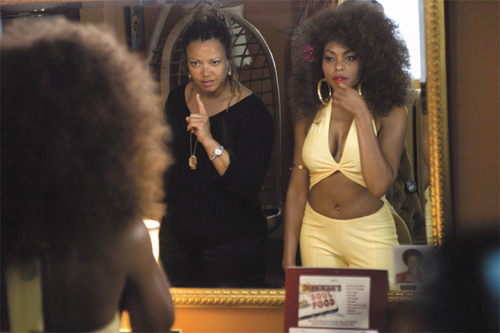BY MARGY ROCHLIN
 (Photo Credit: Brian Davis)
(Photo Credit: Brian Davis)About halfway into director Kasi Lemmons' new film, Talk To Me, a biopic about the seminal Washington, D.C. deejay and ex-convict Ralph Waldo "Petey" Greene, news of Dr. Martin Luther King Jr.'s. assassination breaks out and a full-scale riot erupts on the streets of our nation's capital. For a film budgeted at roughly $12.5 million, the confusion, despair and seething danger of the 1968 emotional uprising is all there: streets are teeming with rioters, two large buildings along with several smaller storefronts go up in flames; an angry mob flips over a taxicab then torches it.
Filmed with four cameras over the course of two nights at an intersection in metropolitan Hamilton, Ontario, Lemmons admits this wasn't her "dream riot." Her version, meticulously storyboarded for the producers, included footage shot with handheld Bolexes and a second location. But, in a way, Lemmons credits the raw power of the scene to inventiveness borne of being told, "There's no money for it."
"It forces you to be continuously creative and imaginative," says Lemmons, who changed her original game plan of having Greene (Don Cheadle) and his best friend and manager, Dewey Hughes (Chiwetel Ejiofor), flee in a car to a different part of the neighborhood. Instead, she had them getting only halfway up the block before being stopped by agitators. "Basically, you invent a device whereby it's happening right there, which actually gave it a greater sense of immediacy."
Back in the late '80s, Lemmons was a working character actress—most famously, playing Jodie Foster's dreadlocked FBI sidekick in Silence of the Lambs. She toyed with becoming a cinematographer while writing screenplays at home and studying documentary filmmaking at New York's New School, before finding her calling as a director. If she has learned to see the upside of a good budget restriction, perhaps it is because her directorial and screenwriting debut, Eve's Bayou, was made for a spare $5 million and ended up being the most successful independent film of 1997. The Southern Gothic drama presented Lemmons with every first time director's no-budget challenge—from figuring out how to juggle tone to making sure that everyone and everything in the moss-covered delta town looked '60s-era appropriate.
So by the time she was prepping Talk To Me, she understood how far production design, wardrobe and makeup can go in establishing time and place. For instance, everything about hair is crucial. "You have to allow for the wig time. Period wigs are hard. If you're shooting on a limited budget, you have to make sure that everyone is so on their toes. The more on top of it the hair department is, the more time you'll have in your day," says Lemmons, who in Talk To Me telegraphs shifts from the '60s through the '80s by showing her primarily African-American cast in tight cornrows, a tidily manicured Afro or, in one case, a blown-out Cleopatra Jones puff.
Lemmons first became involved with Talk To Me when producer Mark Gordon hired her to do a polish in 1994. Though the project initially left her cold, Lemmons says one day she just fell madly in love with it. What got her excited was telling the story of a fearless trash-talker like Greene and Hughes' attempts to promote him into the big time. "[Petey] was completely extemporaneous. So I came to see it as an anti-censorship film, a Black Power film and a love story between two men—like Butch Cassidy and the Sundance Kid. But it also had all this music—and comedy and drama. It had everything. But I didn't see it right at first."
To create a soundtrack with bouncy, soul gems like Archie Bell and the Drells' "Tighten Up (Part 1)" or the real-life Petey Greene's favorite anthem, Les McCann's "Compared to What," Lemmons listened to music nonstop, always keeping in mind how a tune could assist with storytelling. For example, she devised a scene in which Petey tries to reconcile with his estranged friend Dewey, now a disc jockey himself, by calling in to his radio show to request Sly Stone's "If You Want Me to Stay." "What I wanted to do is use the music to express the intention of the character," explains Lemmons. "You know, like, 'what is that character trying to say?' yet I wanted it to still be naturalistic."
Although Lemmons had used the same editor, composer and cinematographer on her second film, the 2001 urban thriller Caveman's Valentine, as she had on Eve's Bayou, she wanted to test herself on Talk To Me. "I could look across a set at Amy [Vincent, her longtime cinematographer] and she could read my mind. But is that too comfortable? Shouldn't you sometimes switch it up and learn a new set of communication skills?"
 HAIR TODAY: Kasi Lemmons (left) directing Taraji Henson,
HAIR TODAY: Kasi Lemmons (left) directing Taraji Henson,
used changing hairstyles to help create a period feel.
(Photo Credit: Focus Features)So for Talk To Me, Lemmons hired French cinematographer Stephane Fontaine, who shot the tense psychological drama The Beat That My Heart Skipped and does his own camerawork. "I wanted Talk To Me to have a very immediate feel," says Lemmons, who spent untold preproduction hours with Fontaine studying movies like Cool Hand Luke, Michael Mann's The Insider—for its skillful meshing of filmmaking styles—and the classic 1970s time capsule concert documentary Wattstax, which the pair referenced so frequently for examples of style, fashion and culture that Lemmons took to calling it, "our black bible."
As straightforward as the storytelling in Talk To Me is, it's filled with clever touches. In one of them, Lemmons took archival clips of key D.C. political events, then intercut it with her own faux historical footage starring her actors, a visual sleight of hand she referred to as a "sort of close-up." For a scene at an outdoor James Brown concert, Lemmons credits her first assistant director, Walter Gasparovic, with stealthily rotating 400 people until it resembled a horde of 10,000. "He is truly gifted," she says, of Gasparovic's multitasking ability to keep spirits high amongst the extras while making sure the same faces never made their way into the crowd shots. "Walter would say, 'Okay, you. I saw you a second ago. Let's put you back and bring this lady forward.'"
 LOVE STORY: Kasi Lemmons wanted to give a sense
LOVE STORY: Kasi Lemmons wanted to give a sense
of immediacy to the story of fearless, trash-talking
deejay Petey Greene played by Don Cheadle.
(Photo Credit: Focus Features)It might have been Lemmon's work in front of the camera that taught her how to shoot one of the key emotional moments in the movie. In the scene, 10 years have gone by and Greene and Hughes meet at a pool hall. At the time, the film was only four days into production. "We were just starting to feel out how each of us works," says Lemmons, who announced to her cast the unconventional approach she was taking: no prosthetics and no tricks to convey the passage of time. "So we didn't do much to their faces to age them," she says. "I told them, 'I don't want to do anything that looks fake. Let the weight of the years just settle on your frame, your body, your face. I just want you to act it.' And it was one of the my favorite things about the scene."
Lemmons believes all of her experience contributed to her becoming a director. In 1994, after her agent had been shopping her script for Eve's Bayou and getting a lot of nos, her decision to switch careers was prompted by a birthday morning epiphany. "I woke up certain that I should direct [Eve's Bayou], that I would rather put it in a drawer than have it misconstrued," says Lemmons, who likes to think of her filmmaking as a case of personality informing variety. "I'm very proud of the body of work I've made. I think I've done three very interesting, distinctive films that are different from each other, and yet all of them very me."